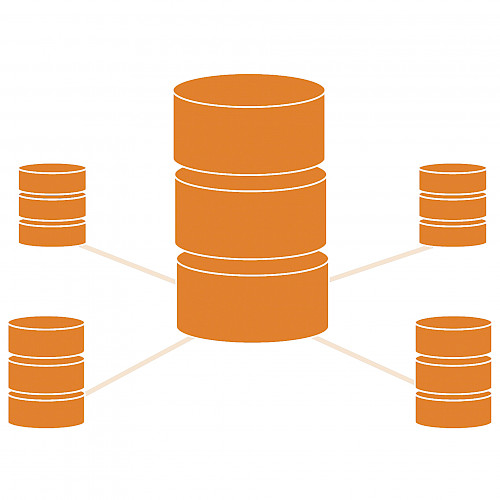
Süddeutsche Zeitung - Development of auction platform Kaufdown
 Open navigation
Open navigation

The base of every good software is a well-working backend. While the so-called frontend represents the part of the software visible to the user, the backend runs the (non-visible) functionalities in the background. Backend development is primarily concerned with the processing and storage of data in the background of an application. The backend is defined as server-side components that can include both software and hardware. There is a close connection with the frontend: user requests from the frontend are translated into the corresponding programming language and executed in the backend. Data entered by the user is also processed. Another important point in backend development is the connection with interfaces to databases or other (backend) applications.
With the trend towards cloud hosting and serverless computing, things have changed for backend developers as well. Many software projects today are implemented with a microservice architecture or even as a flexible cloud-native application. In addition, functional programming also offers new potential for software optimization. In web development, the backend continues to be one of the key factors in the individualization of content management systems or portals.

As a software service provider in Munich, Stuttgart, Leipzig and Frankfurt, jambit has been implementing innovative software projects with experienced backend developers since 1999. The continuous knowledge development and exchange among our jambitees is particularly important to us. This way, we ensure having and using the latest technical know-how about the latest trends and technologies in our projects with world-renowned customers. Due to our broad knowledge, we are able to find the right solution for individual wishes and needs.
In the area of backend development, we rely on microservice architectures with service meshes in most projects, but cloud-native development is also one of our competences. For data processing, we implement projects with relational databases as well as with alternative NoSQL databases. Another important part of our service offering in the backend area is the individualization of content management systems such as Arc Publishing or Polopoly for renowned media companies.
Microservices are an architectural approach that is oriented towards the requirements of modern software development, especially with regard to agile development. For software applications, the need to react quickly and cost-efficiently to constantly changing market conditions has become more important than ever before. In this context, the traditional, "monolithic" architecture approach with countless functions is no longer appropriate for business applications in backend with increasing size and complexity.

In a microservice architecture, complex back-end applications are broken down into loosely coupled so-called "microservices", each of which is limited and focused on a specific function. These microservices can be written in different programming languages and can be connected to each other, for example, via REST interfaces (APIs). In this way, many different microservices can be combined into a functional application via a service mesh.
Despite the many advantages of a microservice architecture, the creation of such a service landscape also holds many pitfalls and traps. While the individual services become clearer, the whole architecture and monitoring usually become more complex. jambit has already successfully introduced and implemented microservice architectures in many projects and can therefore competently advise you in this area on the advantages and disadvantages for your individual project.
jambit references in the area of microservice architectures:
Implementation of a multi-tenant-capable microservice architecture for Audi on Demand
Cloud-native development is another architectural approach to rapidly develop and update back-end applications – while quality is being increased and risk minimized. A cloud-native application is a responsive, scalable, and fault-tolerant app built from scratch to run in the cloud – in any cloud: public, private, or hybrid cloud. It takes advantage of the distributed, scalable, and flexible nature of the cloud. The focus is on the actual writing of code, thereby maximizing business value in development and operation.

The great advantage of cloud-native applications is their independence from individual operating systems or hardware. They can be used flexibly on all cloud platforms and models and can be made available from anywhere. The ability to react quickly to new requirements can give companies a decisive advantage. In coordination with our team of cloud experts, we will be happy to advise you individually on the development of cloud-native applications.
With a content management system, abbr. CMS, websites can be dynamically filled with content without knowing anything about web programming. Via an interface, which is easy to understand, content can be entered into the CMS, and the system itself takes care of the translation to HTML. Content management systems have become an integral part of modern web development. They offer companies the possibility that editors can publish content easily and quickly without technical understanding. However, many companies, especially large ones, often have very specific requirements for their website and need a customization of their CMS. In addition to the implementation of a responsive web design, adaptations in the back-end are often necessary, e.g. when connecting interfaces to other applications. There are similar requirements for the individualization of company portals such as SAP, IBM, or Microsoft Sharepoint.
From a variety of projects with renowned media houses such as F.A.Z. and SZ, Mannheimer Morgen, or the RedaktionsNetzwerkDeutschland, jambit can build on years of experience in CMS development. jambit has already supported numerous publishing houses with back-end and front-end developers in introducing a new editorial system. For FAZ.NET, for example, jambit designed and implemented a cloud-based operating environment on Microsoft Azure and has been providing operation, day-to-day business and 24/7 support for the website and online editorial system ever since then. And for RND.de, jambit enabled the first implementation of the Arc Publishing CMS in Europe with a partner.

jambit references in CMS development:
CMS Introduction with LivingDocs at Handelsblatt Media Group
Integration of the content management system Livingdocs for kicker.de
AI in the Newsroom: Machine Learning for the Paywall of the F.A.Z.
Arc Publishing - Implementation for news portal RND.de
Mannheimer Morgen - Multichannel CMS implementation with Polopoly

Databases are an essential part of most back-end applications. Their task is to store application data in a secure, reliable, and powerful way. The most commonly used databases are relational databases of established manufacturers (e.g. Oracle or Microsoft) and open source projects (e.g. PostgreSQL). Their greatest strengths are guaranteed consistency at all times and the declarative query language SQL. In addition, these systems incorporate decades of research and optimization. However, relational databases are not always the ideal solution. In certain use cases NoSQL databases such as MongoDB, DynamoDB, and Apache Cassandra with alternative data models or special storage concepts may be the better choice. In our projects, we advise customers on the best individual solution.

Functional programming is an alternative programming concept that differs significantly from traditional software development. It promises software that is easier to maintain, test, and scale. It is particularly suitable for applications that must run highly reliable even under extreme performance requirements. This is why functional programming has long since left the academic environment and is becoming increasingly popular in productive software, for example in the banking industry. Since nowadays all major software platforms like JVM or CLR support functional programming languages or language extensions, exotic development platforms and programming languages are unnecessary in functional programming.

Contact us now